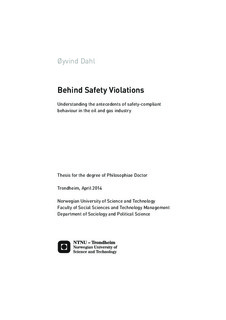| dc.contributor.author | Dahl, Øyvind | nb_NO |
| dc.date.accessioned | 2014-12-19T14:36:41Z | |
| dc.date.available | 2014-12-19T14:36:41Z | |
| dc.date.created | 2014-07-07 | nb_NO |
| dc.date.issued | 2014 | nb_NO |
| dc.identifier | 732858 | nb_NO |
| dc.identifier.isbn | 978-82-326-0168-4 (printed ver.) | nb_NO |
| dc.identifier.isbn | 978-82-326-0169-1 (electronic ver.) | nb_NO |
| dc.identifier.uri | http://hdl.handle.net/11250/268795 | |
| dc.description.abstract | Investigations and analyses typically demonstrate that accidents at work, even those with a relatively limited extent of loss, are seldom caused by one single causal factor. Despite this, some causes are identified more frequently than others and across different types of workplace accidents. One type of such causes forms the point of departure for this thesis, namely safety violations, i.e. actions that are contrary to a written safety instruction. However, rather than focusing on violations as a cause of mishaps and thus embracing aberrant behaviour as a meaningful and satisfactory explanation of bad outcomes, violations are primarily dealt with as a symptom and a consequence of deeper organizational deficiencies. Thus, this thesis aims to go behind safety violations, as indicated in the title. This implies that a system perspective is applied. In addition, violations are addressed from a different and hopefully more constructive viewpoint than that which is common within accident investigations and traditional safety research, which tends to pay more attention to conditions that hinder safety rather than to conditions which foster safety. In this thesis this is done by putting more explicit focus on safety compliance rather than on safety violations. This implies that the main emphasis is on acts that are in accordance with prevailing procedures, instead of acts that are contrary to procedures. In sum then, the main objective of the thesis is to go behind safety violations and to examine and identify the conditions that affect the propensity to act in accordance with prevailing rules, procedures and regulations.
With this objective as a specified course of action, the thesis aims to add new knowledge about the antecedents of safety-compliant behaviour within one particular, highly regulated industry: the Norwegian oil and gas industry. The empirical work of the thesis draws upon both qualitative and quantitative methods and a variety of different research designs – from field experiments, via questionnaire surveys, to semi-structured interviews. The research undertaken is presented in four separate research articles.
The key findings of the thesis are highly related as they all clearly illustrate that safety compliance does not occur in a vacuum. Hence, they all point to the importance of taking the context into consideration. Within this context, the findings of the thesis point to some areas that need particular attention, such as the importance of a favourable safety climate, leaders who send clear messages about the priority of safety, leaders who stay close to the front-line activities, clarity in rules and procedures and unambiguity with regard to the importance of knowledge and understanding of rules and procedures. Similarly, the thesis illustrates that safety compliance at the enterprise level is also a result of the interplay between the organization and actors operating outside the organization, and thus that safety can hardly be seen as a pure product of company internal conditions.
It should also be added that the findings of the thesis are not at all depressing. In fact they are really encouraging, because in essence they implicate that safety (like most other aspects of business) can be managed, and in particular that variations in safety compliance is not a result of mere chance and individual variations. Hence, the implications of the key findings of the thesis should be of importance for proactive measures which aim at improving safety compliance within the oil and gas industry. The findings and the practical implications of these should also be relevant to other high-risk industries, in particular to those where rules and procedures constitute a vital part of the system of safety barriers. | nb_NO |
| dc.language | eng | nb_NO |
| dc.publisher | Norges teknisk-naturvitenskapelige universitet | nb_NO |
| dc.relation.ispartofseries | Doktoravhandlinger ved NTNU, 1503-8181; 2014:122 | nb_NO |
| dc.relation.haspart | Dahl, Oyvind; Fenstad, Jorn; Kongsvik, Trond. Antecedents of safety-compliant behaviour on offshore service vessels. Maritime Policy & Management. (ISSN 0308-8839). 41(1): 20-41, 2014. <a href='http://dx.doi.org/10.1080/03088839.2013.780311'>10.1080/03088839.2013.780311</a>. | nb_NO |
| dc.relation.haspart | Dahl, Oyvind; Olsen, Espen. Safety compliance on offshore platforms. Safety Science. (ISSN 0925-7535). 54: 17-26, 2013. <a href='http://dx.doi.org/10.1016/j.ssci.2012.11.003'>10.1016/j.ssci.2012.11.003</a>. | nb_NO |
| dc.relation.haspart | Dahl, Oyvind. Safety compliance in a highly regulated environment. Safety Science. (ISSN 0925-7535). 60: 185-195, 2013. <a href='http://dx.doi.org/10.1016/j.ssci.2013.07.020'>10.1016/j.ssci.2013.07.020</a>. | nb_NO |
| dc.relation.haspart | Dahl, Øyvind; Søberg, Marius. Labour inspection and its impact on enterprises’ compliance with safety regulations. Safety Science Monitor. (ISSN 1443-8844). 17(2), 2013. | nb_NO |
| dc.title | Behind Safety Violations: Understanding the antecedents of safety-compliant behaviour in the oil and gas industry | nb_NO |
| dc.type | Doctoral thesis | nb_NO |
| dc.contributor.department | Norges teknisk-naturvitenskapelige universitet, Fakultet for samfunnsvitenskap og teknologiledelse, Institutt for sosiologi og statsvitenskap | nb_NO |
| dc.description.degree | PhD i sosiologi | nb_NO |
| dc.description.degree | PhD in Sociology | en_GB |

